Brick stoves, even small ones, have a number of advantages over metal heating equipment. This is due to the rapid heating of iron devices and the corresponding cooling rate. A mini-oven for a summer cottage made of bricks gives off heat for a long time and maintains a comfortable microclimate. The structure can be erected with your own hands, without resorting to the help of a master.
The advantages of installing a small-sized wood-burning stove
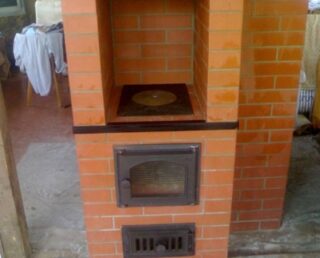
A small stove for a brick house is an accent in the interior of a living room. A number of aspects must be taken into account during construction, from practicality to safety. The models "Dutch", "Russian" and "Swedish" are popular. The first is compact, the second is functional, and the third is often used for heating.
Pros of a brick stove:
- stable heat supply;
- maintaining the desired temperature for a long time;
- during the cooling phase, it absorbs steam released during heating;
- cost effective design;
- you cannot burn yourself on the surface.
Using the equipment over a large area is not rational, since the room will take a long time to warm up. The oven itself takes up little space. During the construction of the structure, it is necessary to follow the masonry technique. Otherwise, violation of the integrity will lead to incorrect operation.
Brick mini-oven schemes

Mini-stoves for summer cottages are divided according to purpose, type of fuel, power and periodically fireboxes. To find the right model, you need to determine the specified parameters. The size and appearance depends on the preferences of the owner of the house and the size of the area.
Small design
Furnace equipment is designed to heat the living room and is rarely used for cooking. The small structure is equipped with a heat generating plate. Some models require the installation of a cast iron hob.
Small cooking stove with heating
The main purpose of stove models is to heat the room and prepare food. The design includes an oven and a hob. The best option for placing equipment is to use it as an interior partition. The structure is used as a water boiler for one circuit, but it will be heated from wood.
Mini oven location

In order to comply with fire safety, as well as for efficiency, the stove in the country house is installed in the finished building. When building, consider the following rules:
- do not mount near an external wall;
- in the central part it is used as an element of zoning;
- erection as a partition is allowed;
- the layout of the beams for bringing the chimney to the street is taken into account.
Small stoves take up little space due to their size: width - 50-70 cm, length 65-100 cm.The heating structure reaches 2.3 meters in height, and the lower limit is 1.5 m.The structure can be equipped with a hob, oven and a water heater.
Tools and materials for building a mini oven
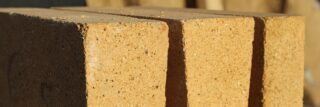
To make a mini-oven from a brick with your own hands, a silicate, refractory or ceramic type of brick is used. The second option is preferable, because.allows you to create a fireproof structure. Fireclay and refractory types are distinguished from refractory bricks, which are most suitable for the external masonry of the firebox.
As a tool you will need:
- rule;
- stove and hammer-pickaxe;
- fun for rubbing the solution;
- building level and plumb line;
- a brush for cleaning the canal;
- rasp, angle, pliers and chisel.
Brick laying is carried out on a mortar, which is prepared from clay, selected in accordance with the type of material.
To prepare the mixture, take river sand with a fraction of 1-1.5 mm and clay in a ratio of 2.5 to 1. Bring the solution to the desired consistency with water. A simple option is to purchase a ready-made composition for laying the oven.
Traditionally, the foundation of the house serves as the basis for a small brick oven for a summer residence, but at the same time they should not touch. Waterproofing materials are laid on the monolith. If the floor is made of wood, the floorboards are removed from the installation site. Keep in mind that the foundation of the structure is larger than the stove itself.
Masonry algorithm
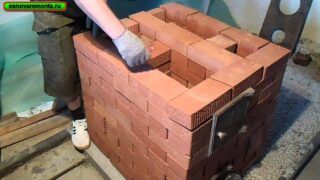
The construction of the stove takes place on a finished base, which protrudes beyond its limits by 10-20 cm. From the side of the firebox, experts recommend leaving 50-70 cm for the installation of the pre-heating platform. The construction of the structure is carried out on clay-sand mortar according to the prepared drawings.
Lay the first two rows solidly. On the third, start laying out the blower chamber by installing the door on the wire. The fourth level involves the further laying of bricks, strengthening the blower and equipping the ledge for the grate. Mount the grille itself without mortar on the fifth row, leaving gaps of 5-7 mm.
Having reached the sixth row, install the fire door in the portal. Secure it with steel wire or mortar strips. From 7 to 11 levels, continue to lay out the firebox.
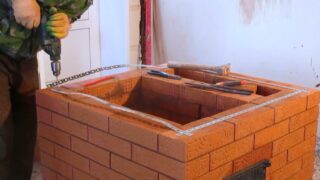
After completing 11 p. lay a metal strip or corner to support the hob. Then fit the panel decking. From 12 to 15 rows, begin to build walls around the chamber and the chimney coming from the firebox. Use a sheet of flat slate to fold the fireproof roof. At 16 p. cover the hob with solid brickwork and continue to form the smoke outlet. When finished, install the chimney door to remove soot and debris - use a steel plate. Fix the element with mortar. From rows 19 to 22, lay bricks according to the scheme.
Lay out the niche for the oven from the 23rd row, on the next one, fold the walls and install the cabinet. At the bottom of the chamber, place strips of asbestos cardboard around the perimeter of the niche. Wrap the oven with a rope made of the same material. These works are aimed at strengthening contact with bricks and better heat accumulation. Complete the cabinetry.
From rows 25 to 27, lay around the oven. On the next level, install the second door for the street smoke channel. At 29, continue laying and make the first valve, install the second on row 32, which is also the basis for a brick or metal pipe. From 30 to 35 - continue building the furnace according to the project.
After completing the work, dry the stove and perform a test kindling. This event is best carried out with a fire service specialist to draw up an act on the safety of the structure.
Possible problems
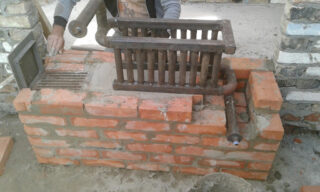
Small-sized brick stoves for a house are recommended to be erected in a small building or temporary hut. For example, such buildings with a heating structure can be built next to the main cottage. Such a structure is ideal for supplying heat to a small area, to which it is impractical to supply central heating, including for a workshop.
Before starting construction, you should familiarize yourself with the common mistakes:
- Brickwork is carried out without seam binding.
- The use of metal plates or elements in areas of contact with fire.
- The location of the brick in the pipe on the edge.
- Cladding without regard to the degree of expansion of the materials.
- Incorrect insulation of sawn timber.
- Incorrect placement of the oven on the base.
A small brick construction for heating is relevant in the country, in the house and in the garage. Depending on the purpose, the size and place for installation are selected.








